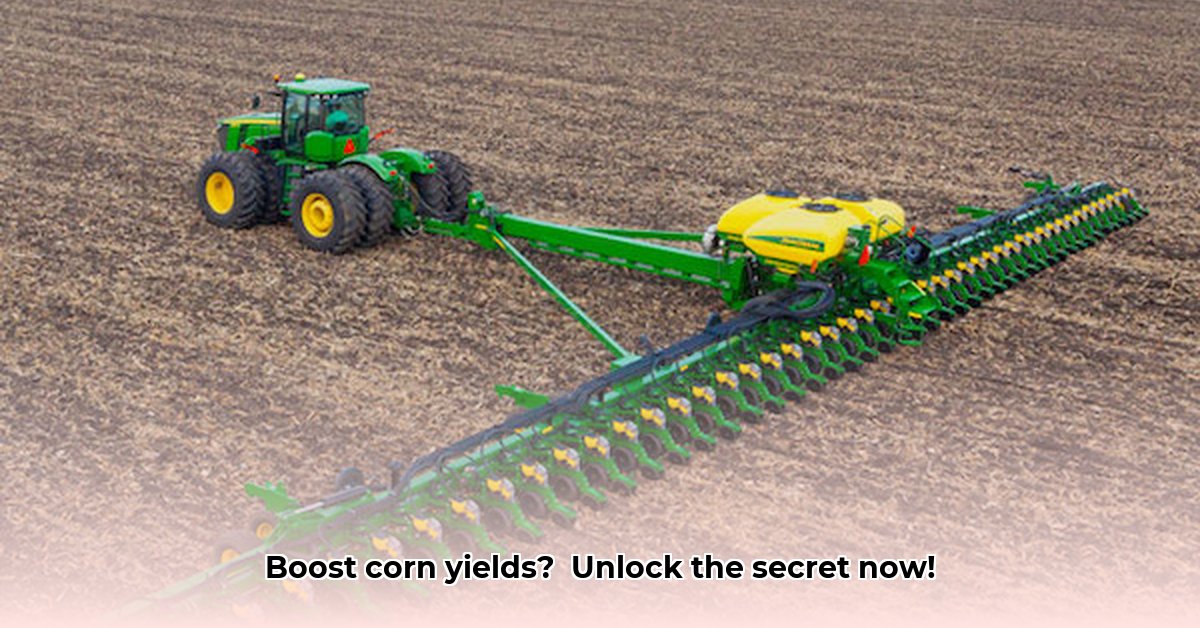
Tractor Corn Planter: Precision Planting for Higher Yields and Sustainability
Want bigger corn harvests and a more sustainable farm? Precision planting is the answer. This isn't your grandfather's corn planter; today's machines use GPS, computers, and smart technology to place each seed precisely where it needs to be. This translates to less wasted seed, less fertilizer, and a bigger, healthier crop. This guide covers everything from understanding different planter types to maximizing data collection and analysis, enabling informed decisions for a thriving farm. For more information on tractor seeders, check out this resource.
From Simple Beginnings to High-Tech Planting
Corn planting has evolved dramatically. Early methods involved manual seed placement, a labor-intensive process. The tractor revolutionized planting, but early tractor-drawn planters lacked precision. Modern planters, however, harness advanced technology for unprecedented accuracy.
Decoding the Modern Tractor Corn Planter
Modern tractor corn planters are sophisticated seed-delivery systems, ensuring each seed is optimally placed for germination and maximum yield. Key components include:
GPS Guidance Systems (Global Positioning System): These act as the planter's navigation, using satellite signals to guide it across the field, ensuring consistent seed spacing even on uneven terrain. This minimizes overlaps and gaps, maximizing seed efficiency.
Automated Seed Placement Mechanisms: Automated systems meter and drop each seed at the precise depth and spacing, crucial for uniform emergence and growth. This ensures every seed has optimal conditions.
Hydraulic Adjustments for Planting Depth: Hydraulic controls automatically adjust planting depth to maintain consistency across varying terrain, ensuring optimal soil contact for germination regardless of the field's contours.
Data Integration and Monitoring Systems: Sensors collect real-time data on planting speed, seed depth, and spacing, which is then used to fine-tune parameters for optimal efficiency. This provides a real-time view of planting progress.
Different Types of Planters (relevant to corn): Row planters, the most common for corn, place each seed in its own furrow. Air seeders, while less common for corn, offer consistent seed distribution and are often used for small grains.
The Upsides and Downsides of Precision Planting
Precision planting provides numerous advantages, but it's essential to acknowledge the challenges.
Advantages:
Higher Yields: Consistent planting leads to uniform development, resulting in higher yields and increased profitability. Studies show yield increases ranging from 5% to 15%, depending on factors like soil type and precision of implementation.
Reduced Seed Waste: Precise placement minimizes wasted seeds, leading to significant cost savings. Precision planting can reduce seed waste by up to 30%, according to research from Iowa State University.
Improved Resource Use: Efficient planting optimizes water and fertilizer application, promoting sustainable agriculture and reducing environmental impact.
Challenges:
High Initial Investment: Precision planting equipment can be expensive, requiring substantial upfront investment.
Technical Expertise Required: Operating and maintaining these systems requires specialized training and ongoing knowledge.
Data Interpretation: Effective utilization of the collected data requires significant understanding and skill. While research widely supports yield increases, some studies indicate that the magnitude of these increases can be variable and depend heavily on correct implementation and data analysis.
Actionable Steps for Farmers Considering Precision Planting
Ready to implement precision planting? Follow these steps:
Assess Needs and Budget: Evaluate farm size, soil types, planting objectives, and available budget to determine suitable technology.
Research Planter Options: Research various manufacturers and models, considering factors like field size, crop type, and desired level of automation.
Implement GPS Guidance: Accurate field mapping is crucial for effective GPS guidance system implementation.
Data Interpretation and Utilization: Learn to interpret the collected data to optimize planting strategies for subsequent seasons.
Long-Term Planning: Plan for technology upgrades and maintenance to ensure ongoing efficiency and accuracy.
The Future of Precision Planting
The future of precision planting includes AI-driven optimization, further integration with other precision agriculture tools, and sustainable manufacturing practices. This will lead to even greater efficiency, sustainability, and profitability.
Resources
- Iowa State University Extension and Outreach: Precision Agriculture (Example resource – replace with relevant and up-to-date links)
- Example Manufacturer Website (replace with actual manufacturer website)
Key Takeaways:
- Precision planting significantly boosts yields and resource efficiency.
- Choosing the right planter depends on farm scale, crops, soil, and budget.
- Return on investment (ROI) varies widely depending on the specific technology and farm context. Thorough research is vital before investing.
- Data-driven decision-making is crucial for maximizing ROI.